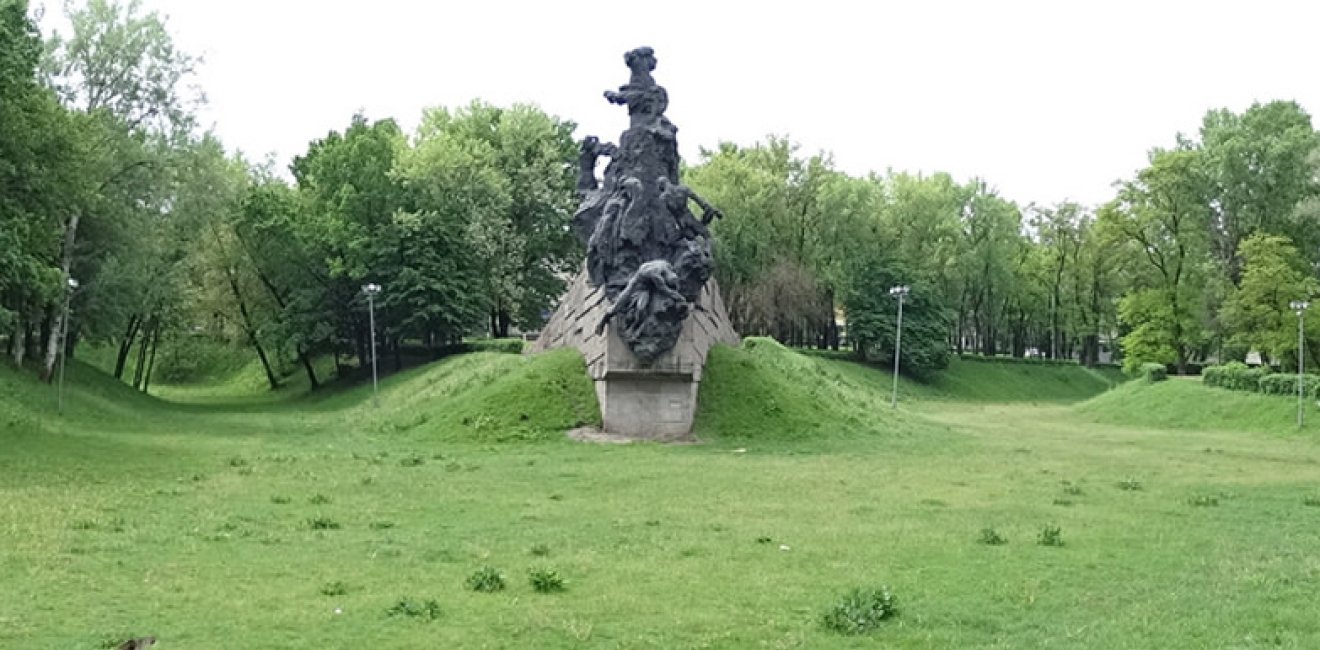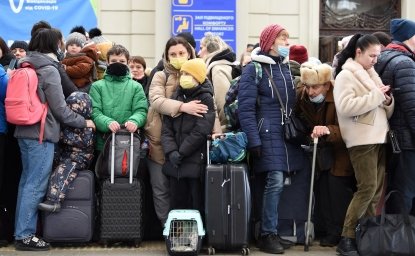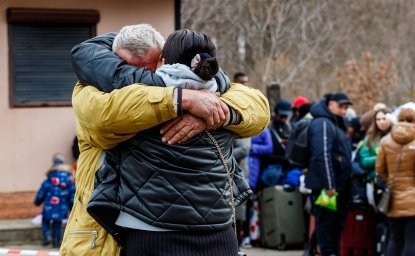Among the tragedies of the Holocaust, Babi Yar occupies the singular position of being the largest massacre at its time: 33,771 people were murdered there over two days in September 1941. Even after all the murders of the Holocaust that followed, the killings at Babi Yar remain among the three or four largest massacres.
Earlier this year, I had a chance to sit down with Lev Simkin, a Russian legal historian of the Holocaust and a former Kennan Institute Galina Starovoitova Fellow on Human Rights and Conflict Resolution.
Simkin’s legal training gives him a particular advantage in interpreting historical events: he is able to understand and place in context the proceedings of the postwar trials that the Soviets conducted of the masterminds and their accomplices in the killing of Jews.
Simkin likes to emphasize that he is not a professional historian, and that he decided to write on the Holocaust in Ukraine as an individual seeking answers to the impossible questions confronting those who deal with the subject of the Holocaust. His books are meticulously researched, with individual stories relayed with the kind of specificity that renders them fully alive. This is the result of Simkin’s working with trial documents, where witness testimony can bring into the light of day the minutest details of a particular incident, allowing a researcher to put together the full picture with granular precision.
Simkin is the author of several Russian-language books, including Short Will Be the Sentence («Коротким будет приговор») and One and a Half Hours of the Retribution («Полтора часа возмездия»). The former elaborates the role and behavior of ordinary citizens in the occupied Soviet Union, including during the time of the Babi Yar tragedy. He is now investigating the role of Friedrich Jeckeln, considered to be the mastermind of Babi Yar and other major massacres of the Holocaust.
Our conversations were conducted in Russian over a period of several weeks during Simkin’s research visit to Washington, D.C., in April and May 2016. They served as a foundation for my article “What If You Had Been Our Neighbors?” Here we are publishing the rest of the interview.
Q. How did the Holocaust in the Soviet Territories differ from the Holocaust in Western Europe?
A. In practice, the Holocaust began in Ukraine. Why do I say this? If you look closely, in Poland they had ghettos in 1941, but Jews were not yet being killed there. And here, from the very beginning, they began to murder, to shoot people. Einsatzgruppen came, made lists of Jews, and killed women and children. All of this began only on June 22 [when Germany attacked the Soviet Union] or, perhaps, a little later—in late June of 1941. Why?
Hitler believed that the most dangerous Jews lived in the Soviet Union. In his view, they were inherently Bolshevik. And so the Nazis equated Soviet Jews with saboteurs, with partisans. Communists and Jews were seen as the same thing. So they started rounding them up and murdering them. In some places in Ukraine they organized ghettos, and so the Jews were able to live for another couple of years. And in some places, such as Kyiv, there was no ghetto. They gathered up the Jews right away, posted the infamous notice—“All yids of the city of Kyiv and its vicinity must appear . . .”—and assembled and shot them in Babi Yar.
Q. Another thing that seems to have made the Holocaust in the Soviet territories so different is that in contrast to Western Europe, where Jews were shipped off elsewhere to be murdered, here the murders took place before the neighbors’ eyes.
A. Yes, that was the case, both in Ukraine and in Poland. The same would have happened in Russia—and, in part, it did happen in the occupied territories in Russia—for example, in Rostov-on-Don, in the Zmiyovksaya Hollow. There it also happened before the neighbors’ eyes. And not just before their eyes but with their participation.
Q. In your book, Short Will Be the Sentence, you describe terrible things that ordinary people did to their Jewish neighbors. Have you found an answer for yourself as to how something like this was possible?
A. I partially answer this question in the book—well, I try to find a way to answer it. There is anti-Semitism, which had always been present in these “bloodlands,” as Timothy Snyder calls them. There were memories of pogroms. During Soviet times, at first they fought anti-Semitism, but in fact it never went away, because many people came to associate Jews with those in charge. Not because so many Jews suddenly became bosses. More were in charge than before, but not as many as today’s anti-Semites claim or as Hitler portrayed it. In reality, the percentage was very small. But before that, people had never seen Jews in positions of power, and that, of course, jumped out at them.
I also explain it by general emotional hardening. People had already survived Holodomor, they had survived [Stalin’s repressions of] 1937. There was hardly anything left [in terms of violence] that could surprise these people. In addition, people lived badly, and when every piece of clothing had tremendous value, imagine what value the freed-up living spaces represented! Of course, these factors played a role. [Here Simkin refers to the fact that many among the local population benefited materially from the murders of the Jews.—IT]
Q. So could we say that this particular form of the Holocaust, carried out right before the eyes of the neighbors, was perhaps possible specifically in that part of the world and not in Western Europe? As you say, there were Holomor, 1937, and even before that, the bloody civil war. . .
A. I believe that it might have been possible in Western Europe as well. It probably just wouldn’t have been so visible. Because there, and especially in Germany, the Nazis were still concerned with public opinion. There is the famous story of the Jews from Rosenstrasse in Berlin who were married to non-Jewish women. They were arrested, and their wives stood up for them, and the women didn’t stop [protesting] until [their husbands] were freed, and these Jews survived through to the end of the war. So that also happened, though to be sure, [a protest of this kind] couldn’t have happened in occupied countries.
But still, even in Germany, where the Jews were more assimilated than anywhere else, where there were so many Jews who had fought on the side of Germany in World War I, Jews were struck by how quickly their friends and neighbors turned against them.
For example, at the Holocaust Memorial Museum in Washington I have been listening to oral histories. One Jewish woman, who [lived in Germany during the war and] now lives in San Francisco, tells the story of how the same boys, her brother’s classmates, with whom she took dance classes, suddenly started behaving differently toward her.
And you see, this is what the Jews felt so hurt by in the early days: how people’s attitude toward them changed. This was the horror that they experienced then. And her brother was told, you cannot be in this club. They arrested him, took him to the police department. Then her father was taken to Buchenwald. But they managed to break away somehow.
So yes, in Germany too, they betrayed their longtime Jewish neighbors. It’s just that in the East, life was poorer, more frightening, and so the betrayal assumed more severe form, that’s what I think.
Q. Talk about Friedrich Jeckeln, the man who is believed to have been the mastermind of Babi Yar and who thus, in essence, started the Holocaust.
A. Jeckeln’s name is mentioned in just about every book that has to do with the Holocaust and those years. But there is only one tiny book in German specifically about him.
He was appointed SS Obergruppenfuehrer and Police Leader, first in Ukraine, then in Riga. Why did I become interested in him? First of all, because he was an SS Obergruppenfuehrer, a very high rank, equivalent to colonel general. In Yad Vashem, the Israeli Holocaust Museum, I found his correspondence with Heinrich Himmler and other top-level Reich leaders.
Yet, he was among the top ones in terms of murdering Jews. Why is this interesting? There is a view that it was Einsatzkommandos that murdered the Jews; that’s what most books on the Holocaust say. The assumption was that the top leader of the SS and police in Ukraine would have just sat there in the headquarters and coordinated things. But in reality, Jeckeln had far more forces under his command than were available to Einsatzkommandos. Most of those murdered in Babi Yar in the first two days – some 20,000 people – were killed by 45 police battalions that were under Jeckeln’s direct command, and the remainder – by Einzatzkommandos.
How did it happen in Babi Yar? You see, prior to Babi Yar, Jeckeln had already had experience with mass murders in other cities in Ukraine, including Berdichev, which is described by Vasily Grossman in his Black Book. It was Jeckeln who directly managed it. It turns out that he had a special execution platoon. He had an assistant, and here, at the Holocaust Museum in Washington, I discovered that this assistant had the title of Chief of Staff in Charge of Counteracting Gangs and Jews. This assistant was later tried in the German Democratic Republic.
Jeckeln was the key figure when the question of Babi Yar was being decided. What moved them to immediately commit murder? At the end of the day, none of this had ever been decided overnight. They could have organized a ghetto in Kyiv too. But after the explosions on Kreschatik, they decided to blame the Jews.
[In September 1941 several bombs detonated at the center of Kyiv on Kreshchatik Street, destroying several buildings, killing hundreds of Germans, and leaving an estimated tens of thousands of Kyiv citizens homeless. Some historians attribute the explosions to a Soviet secret service provocation aimed at turning Kyiv’s population against the Germans.—IT]
Why blame the Jews? What kind of an asymmetrical response is that? Why blame the elderly, the women and the children, who remained in Kyiv? Clearly, this was ridiculous. But it was convenient for them from a bureaucratic standpoint to equate Jews with saboteurs. Because when you are reporting on how many enemies of the Reich you annihilated, you can include the names of all those elderly, women, and children and report that you destroyed this many spies and saboteurs.
It is also possible that the Germans were afraid of responsibility. Because in the eyes of the higher command, somebody had failed to prevent the explosions. There were German organizations headquartered in those buildings on Kreschchatik. They should have figured out that the buildings were booby-trapped. Somebody had to be held responsible. And if they simply said, ”There, we found the guilty party, these Jews,” who was going to object? It’s quite possible that the idea to use Jews as a scapegoat in this matter belonged to Jeckeln.
Jeckeln was a real sadist. He is known to have invented the “sardine packing” method (Sardinenpackung), when people lay down in the murder pits—he called it lying down like sardines—and then were shot. It is specifically Jeckeln’s terminology. And so I became interested: Who was he? How did all of this happen?
As it turns out, he had fought in World War I. He had two wives, a lover. . . . I’ve been collecting this information piece by piece from trial and other materials. He was tried in February 1946 by a Soviet tribunal, and was hanged. But his sentence does not even refer to Babi Yar. Rather, he was tried for something else, for the destruction of the Riga Ghetto [known as the Rumbula massacre] and for all the things that happened later. It was a very large, significant trial, something akin to [a Soviet] Nuremberg trial. It was something of a show trial, where they tried some very important generals who had operated in the Baltics. Maybe that’s why Ukraine didn’t interest them a whole lot—that, or they simply did not know [about his role in Babi Yar]. Ukraine is mentioned in the sentence, but only in passing.
Q. How is it possible that such an important figure in the Holocaust is so little known?
A. There are various reasons. His archives were kept in his home, which burned down during the bombings. Also, these were all closed materials, secret cases. To get access to them, historians had to get permission. And it is only now that people are trying to understand what happens to people during such periods, why everything and everyone turns against the Jews at such moments, and eventually against everybody else. What role does propaganda play? What role do personal qualities play? When I write my books, I consult a psychologist to get a better understanding of human behavior in stressful, dangerous situations.
Q. One of the biggest conceits perpetrated by the Soviets with regard to Babi Yar and other mass murders is that the Jews were not specifically the target of these massacres. The official Soviet version of history stated that the Nazis murdered innocent Soviet citizens, just as the original Soviet monument at Babi Yar still states today. Even today, when you ask people in Ukraine about it, they try to shift the emphasis, pointing out that many other people died there, too—Ukrainian nationalists, gypsies, the mentally ill.
A. I think it’s hard for people to believe that something like the Baba Yar massacre could be possible. Somewhere in the back of the mind there is a tiny doubt: Did it really happen to the Jews for no reason? Were they really innocent? As the saying goes, a brick does not fall on your head for no reason. If there were no reason, then it could happen to me too, but that’s impossible: me, I didn’t do anything wrong! There must have been something these Jews did. . . .
And Ukraine was a poor country; we’ve talked about the property issue. In the Soviet Union, light industry was weak. During the war, who manufactured clothes? What did people wear? Eventually, they would have had to replace some articles of clothing. So they wore things that used to belong to Jews. Until the 1950s, all these Jewish things—clothes, furniture—were being sold in markets all over Ukraine and southern Russia, as well as in Novgorod and Pskov.
In the Polish cinema today they talk about how people live in houses and apartments that used to belong to the Jews. Imagine that your grandmother had moved into one of those apartments. What was she going to tell her children and grandchildren—that the yardman (dvornik) put the previous Jewish owners on a list, and they were taken to Babi Yar? No. She would have said, “Some people lived here, some Jews; they moved away somewhere, they are not here anymore.” People simply push it out of their consciousness.
Photo Credit: Adam Jones: Panorama of Meadow with Soviet-Era Memorial--Babi Yar--Kiev Ukraine- (CC BY-SA 2.0)






